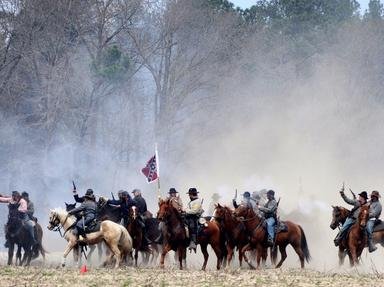Quiz Answer Key and Fun Facts
1. Ten thousand people worked here by 1863, making everything from gunpowder to cannons, ironclad hulls and steam rams. Where was it?
2. When a major city in this state was threatened in 1862, 22,000 soldiers, plus fifty thousand local militia who called themselves "squirrel hunters," hurredly built and manned forts on hills just across the river to defend the city. The defensive demonstration worked and the city was saved from attack. What state was the city in?
3. The Confederate officers imprisoned in this state were given the nickname "The Immortal 600." Despite over a month on rations of cornmeal and pickled onions, they refused to take the oath or be disloyal for better conditions. What state were they imprisoned in?
4. Most of the brass buttons on federal uniforms in the Civil War were made where?
5. The vice president did his part during the Civil War by briefly cooking for soldiers at a fort, where?
6. A colonel climbed the steps to personally take down an enemy flag flying on the roof of a hotel. As he came back down, the proprietor shot and killed him, and one of the colonel's men shot and killed the proprietor. Where did this incident occur?
7. This clothing manufacturer not only contracted to supply thousands of army uniforms, he delivered them in his own steamships. Where was his factory located?
8. Black union soldiers fought stubbornly in hand-to-hand combat, backed against a levee. US gunboats arrived and eventually the Confederates withdrew, and the exhausted Union troops gave chase. This hard-fought battle made assistant secretary of war Charles A. Dana write: "The sentiment of this army with regard to the employment of negro troops has been revolutionized by the bravery of the blacks in the recent battle." Where did this battle occur?
9. Rose Greenhow, a suspected Confederate spy, was removed from house arrest and put in a prison January 18, 1862, where historians believe she continued to send coded messages, based on things like the number of candles in her window and the position of her blinds, though officials apparently caught on and gave her windows only facing the prison courtyard. Where was the prison located?
10. A slave, Robert Smalls, managed to pilot the steamboat Planter out of a harbor, signal the right codes to the forts on the way, and surrender the ship to Union blockaders, along with a map of harbor mines and a codebook onboard. Where did this take place?
Source: Author
littlepup
This quiz was reviewed by FunTrivia editor
bloomsby before going online.
Any errors found in FunTrivia content are routinely corrected through our feedback system.

